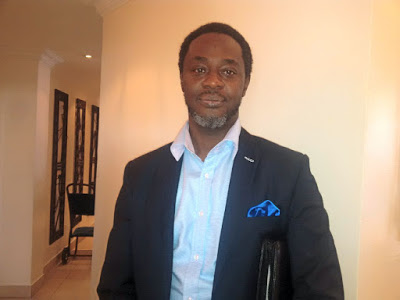Interview
Considering the impact of dredging
activities on the environment, an Environmental Impact Assessment (EIA)
Consultant, Mr Ayo Abiodun, has prescribed more awareness programmes for locals
who engage in commercial dredging activities.
activities on the environment, an Environmental Impact Assessment (EIA)
Consultant, Mr Ayo Abiodun, has prescribed more awareness programmes for locals
who engage in commercial dredging activities.
Abiodun said such awareness programmes was necessary to help the dredgers understand
the impact of their trade on the environment and the need to carry out an EIA
within their work areas.
the impact of their trade on the environment and the need to carry out an EIA
within their work areas.
He noted that the dredgers associations
may be having difficulties aligning with the new guidelines by the National
Inland Waterways Authority (NIWA) that they undertake an EIA before working, in
order to protect the environment.
may be having difficulties aligning with the new guidelines by the National
Inland Waterways Authority (NIWA) that they undertake an EIA before working, in
order to protect the environment.
The EIA Consultant spoke on a number of
important issues and particularly the need for operators to key into ‘best
practice’ in the sub-sector, to protect the environment and communities along
the coastal areas.
important issues and particularly the need for operators to key into ‘best
practice’ in the sub-sector, to protect the environment and communities along
the coastal areas.
What are
the impacts of dredging on the environment and what should actually be the best
practice?
the impacts of dredging on the environment and what should actually be the best
practice?
There are a lot of impacts that have been
noticed with regards to dredging activities, and the best practice anywhere in
the world is to have an Environmental Impact Assessment done before dredging
activities starts.
noticed with regards to dredging activities, and the best practice anywhere in
the world is to have an Environmental Impact Assessment done before dredging
activities starts.
From the environmental impact assessment,
all the environmental impact will be identified, mitigation measures will also
be identified, and there will be a management plan to be able to take care of
any foreseeable environmental impact from that activity.
all the environmental impact will be identified, mitigation measures will also
be identified, and there will be a management plan to be able to take care of
any foreseeable environmental impact from that activity.
That is really the best practise and that
is what NIWA is trying to encourage and follow.
is what NIWA is trying to encourage and follow.
What will
you say the dredging situation is like in this environment?
you say the dredging situation is like in this environment?
I think that in our environment there are
challenges definitely, because best practise is not being implemented fully and
wholly.
challenges definitely, because best practise is not being implemented fully and
wholly.
From your
assessment, what percentage is being done?
assessment, what percentage is being done?
When you are looking at environmental
compliance monitoring, one also tends to look at it with regards to the
economics of the activity. You find out that a lot of companies that are
involved in dredging seem to complain about the financial cost of following due
process.
compliance monitoring, one also tends to look at it with regards to the
economics of the activity. You find out that a lot of companies that are
involved in dredging seem to complain about the financial cost of following due
process.
That is, doing the environmental impact
assessment would prevent some of these foreseeable problems that could arise,
which should not be allowed because at the end of the day, what it does really
is a case of , if these things are identified, it could actually reduce the overall
cost that could arise in future.
assessment would prevent some of these foreseeable problems that could arise,
which should not be allowed because at the end of the day, what it does really
is a case of , if these things are identified, it could actually reduce the overall
cost that could arise in future.
One of the key things is education,
awareness. They need to be aware of the impact of what they are doing, because
a lot of them don’t see the significance, they don’t understand fully, the
significance of the EIA or the significance of the possible impact of their
activity on the environment.
awareness. They need to be aware of the impact of what they are doing, because
a lot of them don’t see the significance, they don’t understand fully, the
significance of the EIA or the significance of the possible impact of their
activity on the environment.
Some of them believe that there are no
communities near them, there is no significant impact. But obviously, there are
other areas that one has to look at like the sea itself, the fishes; there are
so many other things that you look at, even activities of fishermen in the
area.
communities near them, there is no significant impact. But obviously, there are
other areas that one has to look at like the sea itself, the fishes; there are
so many other things that you look at, even activities of fishermen in the
area.
Some people, that is their area and source
of living, so there are so many things that one has to consider. It is very
important that the use of the EIA is encouraged and enforced from the beginning
before activity starts.
of living, so there are so many things that one has to consider. It is very
important that the use of the EIA is encouraged and enforced from the beginning
before activity starts.
What has
been the challenge of enforcement?
been the challenge of enforcement?
Like I said, I think in the past two
years, especially last year, NIWA has put more emphasis on the EIA prior to the
renewal of licenses and all that.
years, especially last year, NIWA has put more emphasis on the EIA prior to the
renewal of licenses and all that.
Some of these dredgers have been doing
this dredging in the past five to 10 years and had never felt the importance
for the EIA. Now that it is being made a priority or the importance being
highlighted by NIWA, they are finding it difficult to align what they have been
doing before to this new approach, which actually comes at a cost that they had
not factored in before.
this dredging in the past five to 10 years and had never felt the importance
for the EIA. Now that it is being made a priority or the importance being
highlighted by NIWA, they are finding it difficult to align what they have been
doing before to this new approach, which actually comes at a cost that they had
not factored in before.
So, a lot of them still run away from the
EIA and the truth is that it obviously cost money to do an EIA, but when you
look at some of these activities, they
have the potential to affect the environment, but also, the revenue from the
operations are not substantial.
EIA and the truth is that it obviously cost money to do an EIA, but when you
look at some of these activities, they
have the potential to affect the environment, but also, the revenue from the
operations are not substantial.
What will
it cost to do an EIA?
it cost to do an EIA?
It depends, because for an EIA, you look
at the activity in that environment. So, the impact will be different from
another area, and the cost will be different because there are so many things
that you will consider.
at the activity in that environment. So, the impact will be different from
another area, and the cost will be different because there are so many things
that you will consider.
Also, if you are dredging near a
community, then that community has to be considered, socio-economics has to be
different. With that, there is no comparison with cost; it depends on the
activity and the environment.
community, then that community has to be considered, socio-economics has to be
different. With that, there is no comparison with cost; it depends on the
activity and the environment.
On the NIWA guidelines for operation?
I think NIWA has identified the
environment as a critical aspect that has to be considered in dredging. Lately,
they have been trying to put more emphasis on awareness with regards to the EIA
of the dredgers’ activities.
environment as a critical aspect that has to be considered in dredging. Lately,
they have been trying to put more emphasis on awareness with regards to the EIA
of the dredgers’ activities.
Also, I think in the past, we had seen
some of these effects of dredging activities. There had been some complaints
that, maybe some dredging activities were affecting the flow of water to some
communities or the access of water from some communities.
some of these effects of dredging activities. There had been some complaints
that, maybe some dredging activities were affecting the flow of water to some
communities or the access of water from some communities.
So, I think NIWA is being more proactive
in ensuring now that moving forward, these new guidelines are to help reduce
any adverse effect of dredging.
in ensuring now that moving forward, these new guidelines are to help reduce
any adverse effect of dredging.
EIA Act
says there should be huge portion of land before the EIA is done, is that not a
loophole?
says there should be huge portion of land before the EIA is done, is that not a
loophole?
Well, it is. That is where NIWA and the
State Government have stepped in. For the Federal Government, what it says is
that it gives conditions under which it makes an EIA mandatory.
State Government have stepped in. For the Federal Government, what it says is
that it gives conditions under which it makes an EIA mandatory.
It does not say that the EIA should not be
done, but it makes it mandatory once you do some things like the size of the
land, if it is like a pipeline project, the length of the pipeline, for
different projects, different guidelines as mandatory.
done, but it makes it mandatory once you do some things like the size of the
land, if it is like a pipeline project, the length of the pipeline, for
different projects, different guidelines as mandatory.
Now, Lagos State and NIWA in their wisdom
have realised that for that, it makes it a requirement for the Federal Ministry
of Environment. But for NIWA and Lagos State, no matter what you are doing,
once it is inside the waterways, is dredging, which should have an impact, an
EIA has to be done. It does not conflict with the FME.
have realised that for that, it makes it a requirement for the Federal Ministry
of Environment. But for NIWA and Lagos State, no matter what you are doing,
once it is inside the waterways, is dredging, which should have an impact, an
EIA has to be done. It does not conflict with the FME.
IS that the
best practice?
best practice?
Different countries have different
standards. Our laws too are evolving, so, every time they review these laws,
they obviously improve on them.
standards. Our laws too are evolving, so, every time they review these laws,
they obviously improve on them.

